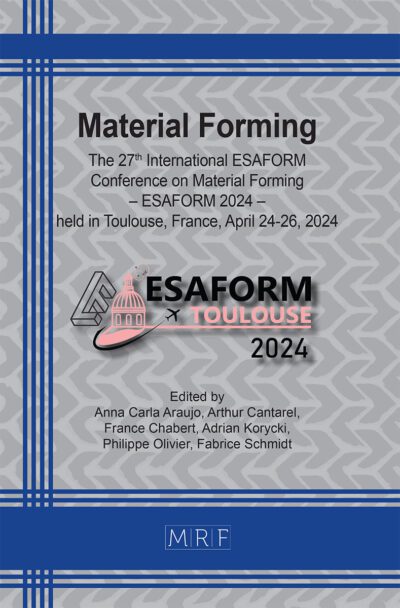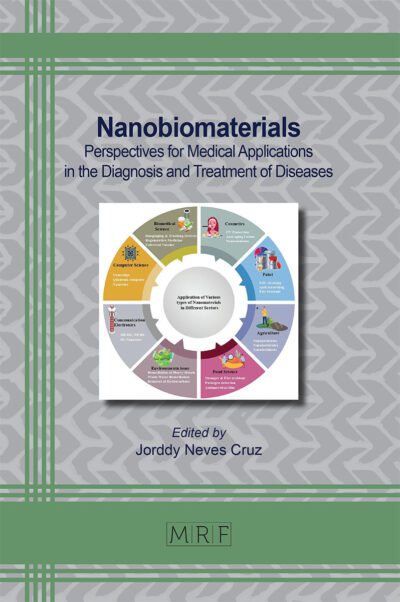Fiber migration in compression molded LFT-D materials: characterization proposal and first results
Christoph Schelleis, Luca Meckes, Frank Henning
Abstract. Fiber mass content (wf) is a key characteristic of long fiber reinforced thermoplastic (LFT) composites. It is defined in LFT-Direct (LFT-D) processing of continuous fiber rovings by the choice of processing parameters. However, in compression molding, the phenomenon of shear induced fiber migration, where wf does change across the flow path, was observed to varying degrees. A density-based method to quickly quantify wf in entire plates is presented and benchmarked against two approaches to thermographic analysis (TGA). The density-based approach was found to deviate from complete wf measurements by -0.4 % improving upon the state-of-the-art TGA results overestimating wf by 1.3 %. This work provides insight into the extent of the fiber migration for glass fiber (GF) reinforced polyamide 6 (PA6) LFT-D materials. For PA6 GF LFT-D with a wf = 33.0 % this deviation is at up to ±16.6 %. Different material combinations of PA6, polycarbonate and GF as well as CF are characterized at low and high wf. Fiber migration is present to various extends for all material combinations.
Keywords
LFT-D, FRTP, Composites, Compression Molding, Fiber Migration, Characterization
Published online 5/7/2025, 10 pages
Copyright © 2025 by the author(s)
Published under license by Materials Research Forum LLC., Millersville PA, USA
Citation: Christoph Schelleis, Luca Meckes, Frank Henning, Fiber migration in compression molded LFT-D materials: characterization proposal and first results, Materials Research Proceedings, Vol. 54, pp 468-477, 2025
DOI: https://doi.org/10.21741/9781644903599-51
The article was published as article 51 of the book Material Forming
![]() Content from this work may be used under the terms of the Creative Commons Attribution 3.0 license. Any further distribution of this work must maintain attribution to the author(s) and the title of the work, journal citation and DOI.
Content from this work may be used under the terms of the Creative Commons Attribution 3.0 license. Any further distribution of this work must maintain attribution to the author(s) and the title of the work, journal citation and DOI.
References
[1] Estin & Co, JEC Observer: Overview of the global composites industry 2022-2027, 2023.
[2] U.N. Gandhi, S. Goris, T.A. Osswald, Y.-Y. Song, Discontinuous fiber-reinforced composites: Fundamentals and applications, Hanser Publishers, München, Germany, 2020.
[3] P. Eyerer, W. Krause, O. Geiger, F. Henning, Development of a Technology for the Large-Scale Production of Continuous Fiber Reinforced Composites, SPE Annual Technical Conference ANTEC (2006).
[4] W. Krause, F. Henning, S. Tröster, O. Geiger, P. Eyerer, LFT-D — A Process Technology for Large Scale Production of Fiber Reinforced Thermoplastic Components, Journal of Thermoplastic Composite Materials 16 (2003) 289–302. https://doi.org/10.1177/0892705703016004001
[5] P. Eyerer, W. Krause, F. Henning, S. Tröster, O. Geiger, LFT-D – A Process Technology for Large Scale Production of Fiber Reinforced Thermoplastic Components, Journal of Thermoplastic Composite Materials 14 (2002).
[6] C. Schelleis, B.M. Scheuring, W.V. Liebig, A.N. Hrymak, F. Henning, Approaching Polycarbonate as an LFT-D Material: Processing and Mechanical Properties, Polymers (Basel) 15 (2023) 2041–2065. https://doi.org/10.3390/polym15092041
[7] C. Schelleis, B.M. Scheuring, A. Hrymak, F. Henning, Study on Mechanical Characteristics of Glass Fiber Reinforced Polycarbonate LFT-D for CoDiCo Structures, in: Proceedings of the 23rd International Conference on Composite Materials (ICCM 2023), Belfast, UK, 2023.
[8] C. Schelleis, A. Hrymak, F. Henning, Optimizing processing parameters for glass fiber reinforced polycarbonate LFT-D composites, in: SAMPE Europe Conference, Madrid, Spain, 2023.
[9] C. Schelleis, F. Henning, A. Hrymak, Comprehensive material development of glass fiber reinforced polyamide 6 LFT-D, 2024.
[10] Y. Song, U. Gandhi, C. Pérez, T. Osswald, S. Vallury, A. Yang, Method to account for the fiber orientation of the initial charge on the fiber orientation of finished part in compression molding simulation, Composites Part A: Applied Science and Manufacturing 100 (2017) 244–254. https://doi.org/10.1016/j.compositesa.2017.05.021
[11] L. Schreyer, J. Blarr, K. Höger, N. Meyer, L. Kärger, Generation of Initial Fiber Orientation States for Long Fiber Reinforced Thermoplastic Compression Molding Simulation, École polytechnique fédérale de Lausanne (EPFL), 2022
[12] A. Radtke, Steifigkeitsberechnung von diskontinuierlich faserverstärkten Thermoplasten auf der Basis von Faserorientierungs- und Faserlängenverteilungen, Fraunhofer-IRB-Verl., Stuttgart, Germany, 2008.
[13] B.M. Scheuring, N. Christ, J. Blarr, W.V. Liebig, J. Hohe, J. Montesano, K.A. Weidenmann, Experimental and homogenized orientation-dependent properties of hybrid long fiber-reinforced thermoplastics, International Journal of Mechanical Sciences 280 (2024) 109470. https://doi.org/10.1016/j.ijmecsci.2024.109470
[14] K. Rohan, T.J. McDonough, V. Ugresic, E. Potyra, F. Henning, Mechanical study of direct long fiber thermoplastic carbon/polyamide 6 and its relations to processing parameters, SPE Automotive (2014).
[15] S. Goris, T.A. Osswald, Process-induced fiber matrix separation in long fiber-reinforced thermoplastics, Composites Part A: Applied Science and Manufacturing 105 (2018) 321–333. https://doi.org/10.1016/j.compositesa.2017.11.024
[16] G.B. Jeffery, The motion of ellipsoidal particles immersed in a viscous fluid, Proc. R. Soc. Lond. A 102 (1922) 161–179. https://doi.org/10.1098/rspa.1922.0078
[17] F. Folgar, C.L. Tucker, Orientation Behavior of Fibers in Concentrated Suspensions, Journal of Reinforced Plastics and Composites 3 (1984) 98–119. https://doi.org/10.1177/073168448400300201
[18] C.L. Tucker, Fundamentals of fiber orientation: Description, measurement and prediction, Hanser Publishers, Munich, 2022.
[19] H. Mavridis, G.D. Bruce, G.J. Vancso, G.C. Weatherly, J. Vlachopoulos, Deformation patterns in the compression of polypropylene disks: Experiments and simulation, Journal of Rheology 36 (1992) 27–43. https://doi.org/10.1122/1.550340
[20] T.A. Osswald, G. Menges, Materials science of polymers for engineers, thirdrd edition, Hanser, Munich, 2012.
[21] J. Blarr, P. Kunze, N. Kresin, W.V. Liebig, K. Inal, K.A. Weidenmann, Novel thresholding method and convolutional neural network for fiber volume content determination from 3D μ CT images, NDT & E International 144 (2024) 103067. https://doi.org/10.1016/j.ndteint.2024.103067
[22] K. Balaji Thattaiparthasarathy, S. Pillay, H. Ning, U.K. Vaidya, Process simulation, design and manufacturing of a long fiber thermoplastic composite for mass transit application, Composites Part A: Applied Science and Manufacturing 39 (2008) 1512–1521. https://doi.org/10.1016/j.compositesa.2008.05.017
[23] M. Bondy, W. Altenhof, Experimental characterisation of the mechanical properties of a carbon fibre/PA66 LFT automotive seatback under quasi-static and impact loading, International Journal of Crashworthiness 25 (2020) 401–420. https://doi.org/10.1080/13588265.2019.1602973
[24] M. Bondy, P. Pinter, W. Altenhof, Experimental characterization and modelling of the elastic properties of direct compounded compression molded carbon fibre/polyamide 6 long fibre thermoplastic, Materials & Design 122 (2017) 184–196. https://doi.org/10.1016/j.matdes.2017.03.010
[25] L. Meckes, Charakterisierung des LFT-D Plastifikates: Methodenentwicklung und Ermittlung der Prozesszusammenhänge mit Fokus auf die Dichteeigenschaften. Master Thesis, Karlsruhe, Germany, 2024.
[26] J. Blarr, Development of Computational, Image Processing and Deep Learning Methods for the Microstructure Characterization of Carbon Fiber Reinforced Polyamide 6 Based on CT Images, Karlsruher Institut für Technologie (KIT), 2024.
[27] B.M. Scheuring, Effect of hybridization in CoDico-FRTPs: Orientation-dependent characterization and analytical modeling in various climatic conditions. Phd thesis, Karlsruhe, Germany, 2024.














